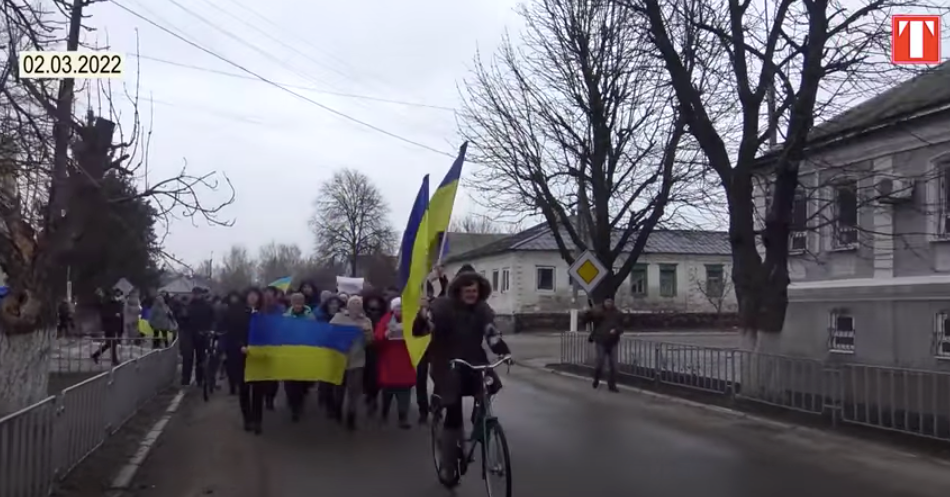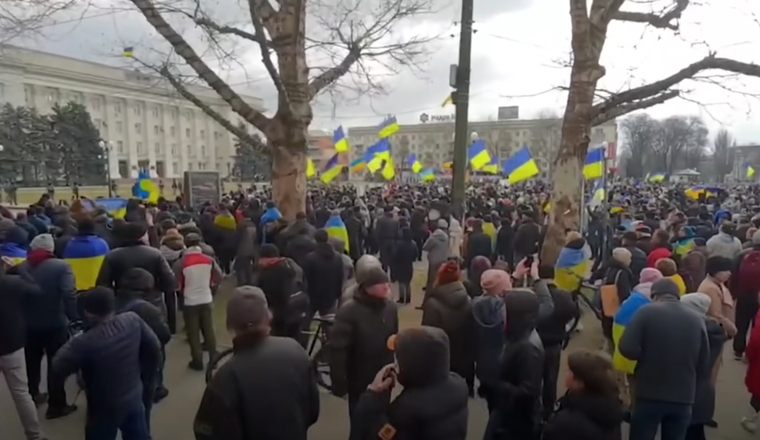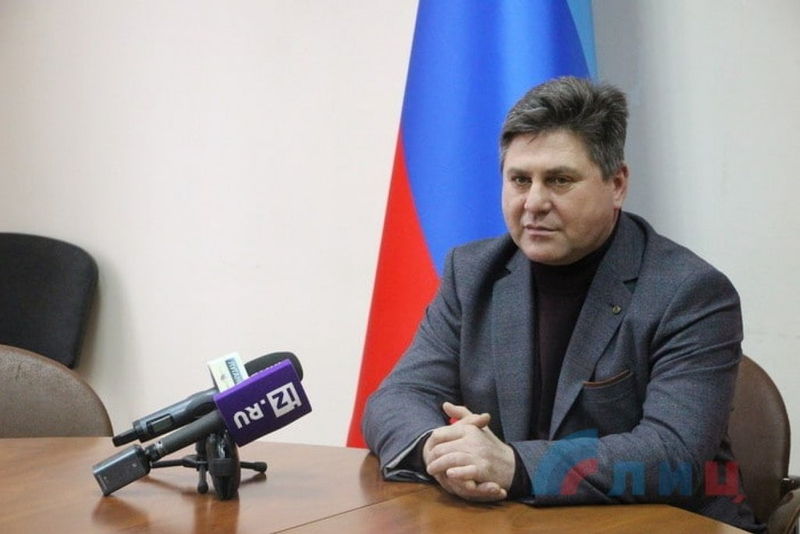Local mayors in East-Ukrainian towns surrounded by Russian forces face a stark choice: do they surrender or stay in power to defend their citizens? It is the old question of local governance in times of war. Until now, many have shown defiance. But the longer the war drags on, the narrower their options become, says Serhiy Kudelia for OpenDemocracy.
 Citizens of Starobilsk protest against Russian occupation (picture municipal authorities)
Citizens of Starobilsk protest against Russian occupation (picture municipal authorities)
by Serhiy Kudelia
With the capture of the first towns by Russian troops, local authorities across Ukraine suddenly face a choice: between collaboration and resistance.
Across southern and eastern Ukraine, local government officials are up against a classic collaboration dilemma – whether to continue their work and thus implicitly recognise Russian occupation or withdraw and leave these cities on the verge of collapse.
The logic behind each choice may seem equally compelling. The mayor of Kupyansk, a town in the Kharkiv region in eastern Ukraine, reported on social media that he met with Russian military representatives and agreed to continue his work in the interests of the local community. By contrast, the mayor of Berdyansk, a town in Zaporizka region in southern Ukraine, explained in an appeal that he had left the city council building and would try to govern the city outside of his main office. He refused to accept the Russian military presence. Other mayors, by and large, have refused invitations to collaborate, but continued performing their duties.
This raises the question about the proper response of the local authorities to the Russian occupation. By forcibly taking control of towns, the Russian military also assumes responsibility for the provision of basic services and the proper functioning of municipal infrastructure. It can only ensure effective governance, however, through reliance on local officials who are intimately familiar with their towns and their needs.
Types of collaboration
In an article on the Vichy regime in France during World War II, renowned social scientist Stanley Hoffman distinguished between two types of collaboration exhibited by local officials.
Voluntary collaboration relied on the initiative of many French citizens, who were preparing for a long-term German occupation and sought to find a place for themselves in the new governing order. Involuntary collaboration, on the other hand, was based on the recognition that the only way to continue serving the interests of the French people was to acquiesce to German domination.
Both types were based on the logic of collaboration d’etat, or state collaboration, which viewed working with German occupation as the most effective strategy to prevent the eventual collapse of the state. Finally, Hoffman also pointed to the collaborationism of individuals outside formal power structures – 'misfits' or political exiles – who sought to use their ties to the Nazi party in order to gain positions of power.
Hoffman’s insights and categories can help us understand the dynamics of occupation and resistance in the current conflict.
Collaboration in 2014
The question of local collaboration with Russian occupation is not new.
Since the war in Donbas started in 2014, the region exhibited all three types of collaboration at the early stage of the Russian-backed separatist insurrection.
The most common type was involuntary acquiescence to the demands of Russian agents and local separatist leaders. The mayor of the city of Lyman, for example, often spoke in favour of Ukraine’s unity, but ultimately had to assist with holding a separatist referendum in the face of coercive pressure from separatist forces. The mayor of Druzhkivka, also in Donbas, initially pledged his support for a united Ukraine, but in his public appearances often repeated separatist demands. He also assisted with gathering funds from local businessmen to support men manning checkpoints and local self-defence militias, and ensured that the local newspaper was published bearing separatist symbols.
Voluntary collaboration, on the other hand, was frequently motivated by sympathy with the pro-Russian cause. In the town of Lysychansk, for example, a city council deputy from the Communist Party of Ukraine agreed to serve as an interim city mayor while the town was under the control of various separatist military units. She maintained close ties to the city’s militant commander Oleksiy Mozgovoi and ensured the adoption of council resolutions pushed by the separatists. In Kostiantynivka, a deputy mayor openly sympathetic to the pro-Russian cause similarly helped with organising a referendum in support of joining the so-called 'Donetsk People’s Republic' while the mayor and other officials fled.
Finally, in a number of towns political outsiders took power with the backing of Russian agents in 2014. The self-proclaimed military governor of Kramatorsk was a former physical education teacher in a local school. The 'people’s mayor' of Mariupol was an owner of the boxing club with alleged ties to the criminal underworld. A local businessman replaced the mayor of Sloviansk after the town was captured by Russian military leader Igor Girkin’s unit.
 Locals in the occupied town of Kherson resist (picture YouTube Unian)
Locals in the occupied town of Kherson resist (picture YouTube Unian)
The new war
In contrast to 2014, the number of local officials who have openly sided with Russian occupying forces has so far remained limited to the heads of two towns and several villages.
The most clear-cut case of voluntary collaboration relates to the Stanytsia Luhanska administration, where Albert Zinchenko has governed the town since 2009. Several days after the seizure of the eastern Ukrainian town by Russian forces last week, Zinchenko appeared at a press conference next to Leonid Pasechnik, head of the self-proclaimed 'Luhansk People’s Republic'. The latter promised to make no changes in the town’s municipal government.
In another case of collaboration, the mayor of Kupiansk, Gennady Matsegora, who is a member of the pro-Russian political party Opposition Platform – For Life, allegedly offered Russian military commanders material assistance in exchange for maintaining order in the town. He was later detained on treason charges by the Ukrainian security services.
 Albert Zinchenko, head of Stanytsa Luhanska sided with the Russians (Source: LITs)
Albert Zinchenko, head of Stanytsa Luhanska sided with the Russians (Source: LITs)
In some cases, defiant local authorities have been backed up by local residents. On 3 March, the mayor of Svatove, a city in Luhansk region, held talks with a Russian military representative in the presence of the local community, who insisted on appointing a local 'military commander'. Speaking in Ukrainian, the mayor asserted that the town had sufficient food supplies and that law enforcement was functioning.
'Please leave the territory of the town and then everything will be quiet,' she told the Russian military. Faced with the angry shouts of a crowd waving Ukrainian flags, several armed men jumped into their cars and drove away.
Awkward co-existence
The most common response, however, has been some form of awkward co-existence between local Ukrainian authorities and Russian occupying forces.
In Melitopol, the first major settlement in southern Ukraine occupied by Russian troops, mayor Ivan Fedorov has continued running the city of 150,000 residents. Despite his open support for pro-Ukrainian rallies, Fedorov said the Russian military has not approached him directly. When Current Time, a media outlet, asked him about 'alternative power structures' created by Russian forces, he responded that he remained fully in charge. 'Our team continues administering the city and solving the problems of town residents. They are not participating in running the town’s communal enterprises and other services,' Fedorov said.
On 2 March, Russian forces appear to have occupied another town, Starobilsk in Luhansk oblast. However, its mayor Yana Litvinova publicly asserted her loyalty to Ukraine and continued performing her duties despite threats. In a Facebook post on 5 March, Litvinova explained that it felt surreal for her to continue taking care of the city despite the presence of the Russian military. 'We are making sure that all social payments are made to locals as they should be. I am not hiding anywhere and if the military wants to meet, we will have a meeting with the entire community,' she said.
Even in Kherson, the first regional centre seized by Russian forces, the local authorities have remained in place. The city’s mayor Ihor Kolyhaev confirmed on his Facebook page on 2 March that the Russian military visited the city council to talk to him. He claimed to have made no deals with them: 'I promised them nothing. I am only interested in the normal functioning of the city. I asked them not to shoot at city residents.'
Following a rally on 5 March in Kherson in support of Ukraine, the mayor praised local residents for refusing to take any humanitarian assistance from Russian forces: 'I am proud of you, Kherson! Kherson is the hero city. Kherson is Ukraine.'
Thus while Ukrainian municipal authorities in occupied towns continue their operations, their public expressions of defiance indicate they have not crossed the collaboration threshold. This categorisation, however, would change the moment any of the mayors start accepting direct orders from the occupying Russian forces or agree to replace Ukrainian state symbols with those of the occupier.
Hero cities
The nature of Ukraine’s municipal response to the Russian occupation so far, and its comparison to the 2014 insurrection in Donbas, points to five key conclusions.
First, the Russian military invasion lacks a well-planned political and administrative dimension. Russian forces may deploy their armoured vehicles around central squares and station soldiers around the city, but there is no one to back them on the administrative level. None of the key local officials has yet embraced Russian narratives about the goals of the invasion. No local officials, with very few exceptions, have been willing to recognise Russia’s sovereign control over towns.
Second, in contrast to 2014, the Russian military has largely avoided removing symbols of Ukrainian state power in the occupied towns. Ukrainian flags still fly over local government buildings. The tactical calculation behind this approach may be to signal that Russians are, in fact, not planning to annex these towns and make them a permanent part of the Russian state. This suggests that Putin’s overall political goal may indeed be their merger into a new political quasi-Ukrainian territory under Russian military tutelage. However, neither the contours of this new territory, nor its ideological basis, have been articulated yet.
The absurdity of Russian claims to have control over Ukrainian cities is exposed with every new act of defiance of city officials
Third, in order to sustain their military occupation of Ukrainian towns, Russians need to ensure that Ukrainians remain responsible for their day-to-day operation. This means that Russian forces would either have to tolerate an open expression of defiance on the part of the mayors or find lower-level bureaucrats who could take over the reins of municipal governance. By ignoring mayoral opposition, however, they may face mounting public mobilisation against occupation, backed by local authorities, which has been already visible in Kherson, Melitopol, Berdyansk and other towns.
These public expressions of opposition to the Russian military presence undermines the very premise of the invasion. By contrast, cooptation of loyalists from within local governing structures could backfire if their authority is challenged by lower-level officials and the public, sparking more disobedience.
Fourth, the legitimacy of local mayors puts them at the centre of symbolic non-violent resistance to Russian occupying forces. They can credibly speak on behalf of the entire community, articulate demands and serve as focal points for coordination of town residents. They also symbolise continuity in Ukraine’s sovereign rule over these localities, and hence the persistence of the Ukrainian state there, despite the Russian military presence. The tenuous nature of Russian claims to have control over Ukrainian cities is exposed with every new act of defiance of city officials.
Finally, if the Russian military occupation continues, it may at some point require local authorities to make a choice between siding with Russia’s political goals or resigning. Then the dilemma of involuntary collaboration that Stanley Hoffman described in the case of Vichy France would become particularly clear.
Some local rulers could justify their continued work under Russian control by referencing the good of the community. Some may see such involuntary collaboration as a lesser evil when compared to the breakdown in communal services and provision of social payments that, should they resign, could affect their most vulnerable residents.
However, as Hoffman stresses, any type of collaboration would only 'increase the immediate, certain and tangible evils' of the occupying regime, such as violence and repression. The end result would involve an end to any material benefits of collaboration and possible reputational damage to local officials.
This is what Russian occupying forces may be counting on as they silently tolerate the defiance of local mayors today. And this is why local Ukrainian authorities will be particularly sensitive about whether their continued cooperation will stop benefiting local residents – and start reinforcing the Russian occupation.
This article was published by OpenDemocracy.
